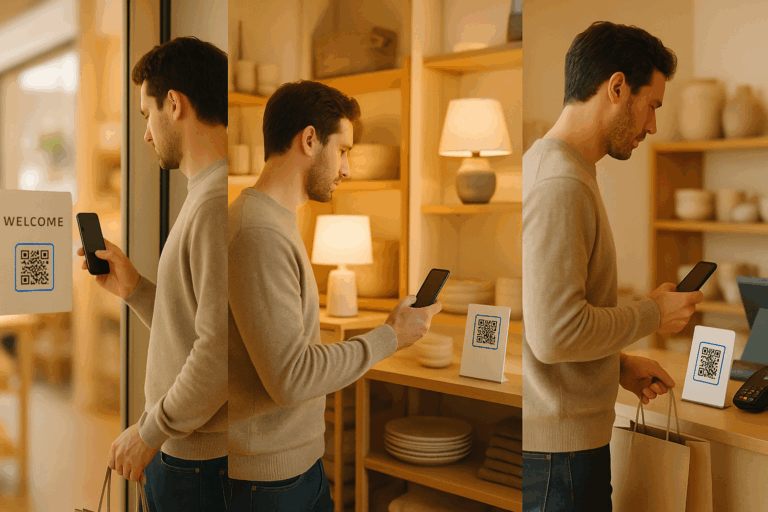The shift from paper to digital receipts looks like an environmental story on the surface. Dig deeper, and you’ll find it’s actually about reclaiming the most underused channel in retail.
Think about it this way: when was the last time you actually kept a paper receipt? Research shows that over a third of French consumers discard their receipts immediately after purchase. That crumpled piece of paper heading straight for the bin is waste, yes, but it’s also your customer walking away invisible, leaving zero trace of who they are, what they bought, or when they might return.
This shift matters more than ever in 2025. France banned automatic paper receipt printing in August 2023. Germany’s regulatory framework now supports digital alternatives. The UK has seen 84% of retailers adopt digital receipt options.
Beyond environmental activism, it’s now about staying competitive in a world where your in-store customers shouldn’t be strangers.
The Real Cost of Paper Receipts (Hint: It’s Not Just Financial)
Every paper receipt represents a conversation that never happened. You hand over a slip of thermal paper, and that’s where your relationship ends. No follow-up. No feedback. No way to reach them again. You’re essentially running a store without any memory of who walked through your doors.
The hidden costs stack up fast. An average hypermarket consumes over 10,000 thermal paper rolls a year – but that’s just the start. You’re missing out on customer identification, CRM growth, loyalty program expansion, and any chance of post-purchase engagement. When customers lose receipts (which happens constantly), returns become headaches, and warranty claims turn into disputes.
Compared to paperless receipts, which eliminate waste entirely, traditional paper slips are environmental nightmares. More than half of all receipts printed in Europe contain toxic chemicals called bisphenol A (BPA) or bisphenol S (BPS), making them impossible to recycle. Germany’s mandatory receipt law, aimed at preventing tax evasion, sparked protests with customers literally taping unwanted receipts to bakery windows to show the waste.
Perhaps most importantly, paper receipts contribute nothing to your digital strategy. While your online customers provide rich data with every click, your in-store shoppers remain anonymous. That’s a significant blind spot when physical retail still drives the majority of sales.
What Digital Receipts Actually Unlock – When Done Right
Here’s where things get interesting. The benefits of digital receipts go far beyond replacing paper – they’re marketing channels disguised as transaction confirmations. When implemented properly, they transform every purchase into a data capture opportunity and every customer into a reachable contact.
The numbers tell the story: digital receipts achieve open rates as high as 75%, establishing them as a highly effective communication channel for marketers. Compare that to typical email marketing open rates of 20-25%, and you’ll understand why smart retailers are paying attention.
Since 2024, personalized engagement leads the digital receipt market with 31.8% share. Clearly, the value of creating new revenue streams through targeted offers, loyalty program growth, and customer lifetime value optimization is clearer than ever.
Digital receipts enable automatic CRM opt-ins without the friction of app downloads. They facilitate seamless loyalty program enrollment, even for customers who weren’t previously members. They provide marketing attribution data showing exactly who bought what, where, and when. Plus, they open channels for automated feedback collection, post-purchase campaigns, and personalized recommendations.
Well, at least ours do wink wink
CX Showdown: Paper vs Digital
Let’s walk through the actual customer experience differences, because this is where the rubber meets the road.
Receipt Retrieval: Paper receipts get lost, crumpled, or fade to illegibility within weeks. Digital receipts live safely in email or mobile wallets, accessible with one tap whenever needed. When your customer needs to reference their purchase six months later, guess which option actually works?
Loyalty Enrollment: Paper receipts might include a URL or QR code that customers ignore. Digital receipts can include seamless one-click loyalty enrollment directly in the receipt itself, removing friction from the sign-up process.
Post-Purchase Communication: Paper receipts are dead ends. Digital receipts can include care instructions for fashion purchases, recipe suggestions for grocery items, warranty information for electronics, or exclusive offers for future visits. The possibilities are endless.
Return Experience: Lost paper receipts create friction and frustration during returns. Digital receipts provide complete transaction history that’s always accessible, making returns smoother for customers and staff alike.
The reality is that digital receipts and customer experience go hand in hand – people don’t remember your brand from the receipt format, they remember how easy you made their entire experience. Digital receipts consistently deliver superior convenience across every touchpoint.

Let’s Talk ROI: Digital Isn’t Just “Nicer,” It Performs
Numbers don’t lie, and the ROI of digital receipts is compelling. Europe Digital Receipts Market size is estimated to reach $933.06 million by 2030, growing at a CAGR of 7.0% during the forecast period 2023-2030.
Consider the direct benefits. Cost savings on paper, ink, and printer maintenance are obvious but relatively small. The real value comes from increased customer data capture, expanded marketing reach, and higher engagement rates. Non-loyalty shoppers engage with digital receipts at a higher click-through rate compared to loyalty members, meaning digital receipts help you connect with exactly the customers you’re most eager to convert.
Traditional feedback relies on customers remembering to respond later – digital receipts change that entirely. Now, include immediate feedback prompts with response rates that dwarf traditional methods.
Retailers implementing digital receipts effectively don’t just cut operational costs – they activate entirely new revenue channels through enhanced customer relationships and data-driven marketing capabilities.
What’s not to love, honestly?
Common Pushbacks – And Why They Don’t Hold
“Our customers still want paper receipts.” This comes up constantly, but the data suggests otherwise. A study by Green America revealed that 89% of respondents would like retailers to offer digital receipts as an option.
“Integration is too complex for our systems.” Modern digital receipt solutions are designed to be POS-agnostic and can typically be implemented within weeks, not months. The UK’s higher adoption rates demonstrate that technical barriers aren’t insurmountable.
“Nobody reads receipts anyway.” Yikes, this argument misses the point entirely. Traditional paper receipts have low engagement because they’re inconvenient and easily lost. Digital receipts with 75% open rates prove that format matters enormously for customer engagement.
“This is just about sustainability.” While environmental benefits are real, the business case stands entirely on its own. Digital receipts are about customer data, marketing ROI, and loyalty program growth. Sustainability is a bonus, not the primary driver. And hey, trees are awesome anyway.
What To Look For in a Digital Receipt Solution
Not all digital receipt platforms are created equal. The best solutions offer POS-agnostic integration that works with your existing systems, not against them. Look for platforms that include built-in marketing and feedback tools rather than just basic receipt delivery.
CRM connectivity is crucial – your digital receipts should seamlessly feed customer data into your existing customer relationship management systems. Real-time opt-in capabilities matter too, allowing customers to join marketing programs directly through their receipt experience.
Trackability and analytics separate professional solutions from basic email blasts. You need platforms that provide detailed insights into open rates, click-through rates, and customer engagement patterns. The ability to personalize receipts based on purchase history or customer segments can dramatically improve results.
Consider delivery options as well. Some customers hesitate to give out personal information like emails, not just for privacy reasons but also because they assume they will be bombarded by irrelevant marketing content. Multiple delivery methods accommodate different customer preferences and privacy concerns.
What Modern Retailers Are Choosing
The momentum across Europe is unmistakable.
The question isn’t “paper or digital?” anymore. It’s: are you making your receipts work for you, or are they working against you? Every paper receipt represents a missed opportunity.
Digital receipts deliver superior customer experience, generate valuable marketing data, and provide measurable ROI improvements over paper alternatives. The technology is mature, integration is straightforward, and customer adoption follows implementation.
Your customers deserve the best and so does your business.
Ready to Make the Shift?
You’ve had the perfect customer touchpoint this whole time. Let us show you what your receipts could be doing: https://www.refive.io/en/demo/









